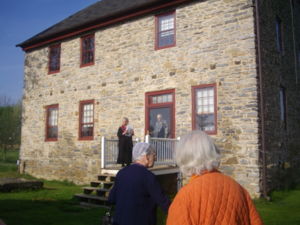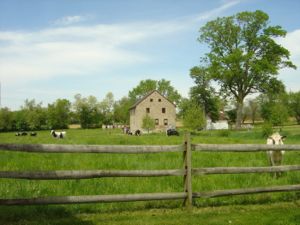Biography
John (Hans) was born in 1683 in Bäretswil, Canton Zürich, Switzerland. He was the first child born to Johann Anton Wäber (1658-1725) and Maria Margarethe Herr (1673-1725) [1] who between 1683 and 1698 had six children, five sons, John "Hans or Johannes" Weber (1683-1775), Jakob Weber (1688-1747), Henry “Heinrich” Weber (1690-1745), George Weber (1693-1772), Hans Weber (1698-1755) and one daughter Maria Weber Landis (1695-1787). All the children were born in Switzerland. There is a legend that they had another daughter Anna Weber Martin (1692-1727) who married David Martin (1691-1784) but she died in 1727 on board the ship Molly, while immigrating to Pennsylvania and was buried at sea. [2] [3] When the Weaver brothers moved to Weaverland they left a 370 acre tract of land, for their sister and brother-in-law, that was located between Jakob's land and his brother Henry's land that David Martin took up upon his arrival in 1727 to Pennsylvania. [4]
In about 1705, John married Barbara Hauser (1695-1724) in Switzerland. Barbara was the daughter Ulrich Hauser and Barbara Meili Hauser. They had four children Samuel, George, David and Jacob. [5]
John immigrated with his parents Maria Margarethe Herr and Hans Wäber to Pennsylvania in 1710. John's mother Maria Margarethe Herr was the daughter of Reverend Hans Herr the religious leader of the 1710 Pequea Colony.
The 1710 Pequea Colony received the original warrant for a tract of land in the Conestoga section of what was then Chester County, Pennsylvania Colony, granted by Edward Shippen, Griffith Owen and Thomas Story to this group of Swissers. The warrant appeared to have very liberal terms, indicating that it was done on the explicit instructions of William Penn. The land agent for this transaction was Johann Rudolph Bundeli (Bondeli), whose name led all the others in the original warrant. Bondeli, a Swiss Bernese patrician, who worked as an agent for Franz Louis Michel von Schwertschwendi of Ritter & Company, on June 30, 1711 patented an additional 500 acre tract of land adjacent to and north of the colony for himself. Bondeli's 500 acre tract of land was part of his commission paid by Ritter for establishing the Swiss colonists in Conestoga. About a month later Johann Anton Weber, his sons and the sons of Jakob Guth, Sr. (d. 1730), executed an agreement of lease with Bundeli for this newly acquired land which adjoined the Pequea or Neu-Strassburg settlement. The Webers and the Guths agreed to use that land under a system of rents, which were to be collected at Bundeli's house in Philadelphia on the first day of each year.
Some time during the late summer of 1711, perhaps in September, the Weber family moved to Conestoga. Between 1711 and 1717 Johann Anton Weber directed his sons in establishing a small plantation on the Bondeli tract, which they had dubbed "Weizenthal", or wheat-land, a name still used in that area although no longer in reference to the Weber lands. From 1711 to 1712 several buildings were erected on the Weizenthal tract: a log house, a log barn and a stable, and a number of smaller farm structures. The larger and more complicated buildings were probably built under the direction of Jakob Guth, Sr. who had training as a house-carpenter, the closest profession in those days to what is now known as an architect.
In 1723 three of John's brothers, Jakob, Henry and George, moved south of the Conestoga Creek along Blue Ball Run. Like the lands at Weizenthal, the tract was timberless when the brothers arrived. The Welsh had been making improvements in the area, while some Swiss and Germans settled in Weber-Thai, or Weaver Dale now called Weaverland, a name which has remained in use to this day. It was so called from the Webers or Weavers who took up between two and three thousand acres of land in 1723/4. George Weber and Hans Guth, brothers-in-law, and Jacob Weber and Henry Weber, all Swiss, were the first settlers, contiguous to the Welsh. The name "Guth'" became "Good." The Webers and Goods had settled in Lancaster County twelve or fifteen years earlier and lived near the present city of Lancaster. The Weaverland settlement became well-known during the 18th century as a center of fervent activity that attracted many devout and "newly-awakened" to the area. [6]
In 1735 John built a stone home called the Weber "Weizenthal" Pioneer Home to replace the old family homestead. This home still stands and is located at 1835 Pioneer Road, Lancaster County, Pennsylvania.
John wrote his will on January 8, 1775 in Lampeter Township, Lancaster County, Pennsylvania, and died there shortly after. His will was proved in court on 29 Apr 1755.[7] John & Barbara were probably buried at Weizenthal along with his parents Johann Anton Weber and his wife Maria. [8]
Sources
- ↑ I. From Database of Brent L. Rodes at rootsweb.com 06/10 - Her last name being Herr and the daughter of Hans is speculative.
II. Only one Maria is listed as the daughter of Hans Herr and Elizabeth Kendig in T.W Herr. That Maria married Benedict Brackbill. This Maria could be an unlisted daughter of Hans Herr. using "Margarethe" as the preferred name to distinguish between the two.Topchy-1 13:16, 18 March 2014 (EDT) Reference: Genealogical record of Reverend Hans Herr and his direct lineal descendants : from his birth A.D. 1639 to the present time containing the names, etc. of 13223 persons," Lancaster, PA: T.W. Herr, Examiner Printing House; ©1908 Page 1, Line #8
III. Notes on Margaretha Sieber Herr - April 2013 by Jack Gilchrist - There is much speculation and genealogy records that suggest that Margaretha Sieber "Maria" Herr (b.1663, d.1725) and her sister Maria Herr (b.1673, d.1725) are in fact he same person. This is supported by the fact that currently they are both recorded to have died on 1 Dec 1725 in Strasburg, Lancaster Co., PA. The birth dates of Margaretha's children by John Weber (Johann Anton Weber) between 1683 & 1695 and those of her sister Maria between 1702 & 1704 in the same place with the father being Benedictus Brackbill (b.1665, d.1720) would have made this a possibility if Margaretha divorced John Weber (Johann Anton Weber) and remarried in 1701 to Benedictus Brackbill. However I have found nothing in the history of any of their of spring to suggest his happened. Combined with the fairly well documented fact that John Weber (Johann Anton Weber) lived until 1724 and divorce was rare in the Mennonite community I continue to believe Margaretha and Maria Her were two separate individuals. - ↑ JD Weaver Website Anna WEBER was born about 1700.19 She died in 1727 in at sea on Molly.19 She died at sea on the "Molly". According to family tradition, her share of the land in Weaverland was given to her husband David Martin. See Note on her marriage. Parents: Johann Anton WEBER and Maria Margaretha HERR. Spouse: David MARTIN. David MARTIN and Anna WEBER were married before 1727. Family tradition said that his (David Martin) first wife who died at sea on the Molly was Anna Weaver, sister of Henry , George, Jacob, and John Weber of Weber's Thal. However, Darvin Martin argues that this is highly unlikely. He argues in his article that the families probably never knew each other and that it is highly improbable that if he had a wife who was lost at sea, her name was Anna Weber. I would like to see more proof before I throw away this wonderful tale which M. G. Weaver quotes in his book. Jay Weaver.
- ↑ Find A Grave index - Anna Weber Martin
- ↑ J.D. Weaver Website another traditional narrative that his first wife, who died at sea, was a sister to the three Weber brothers, and the reason that they so thoughtfully provided for David Martin's future home was that they desired to give her the best of their pioneer homes, has not been proven authentically, yet we join in the belief that all circumstances point to the correctness of that sad narrative, and that the development of this section was followed as planned by the Webers, and that David Martin and his descendants never disputed the right nor the propriety of the name of the vale, to be given to those, who first chose the site of their settlement.
- ↑ Clemens Family Page
- ↑ Historic background and annals of the Swiss and German pioneer settlers of southeastern Pennsylvania, Page 219.
- ↑ Lancaster, Pennsylvania, Will Book B, pp. 102-103.
- ↑ Jack Gilcrest - Find A Grave
See also:
- Reference from Mennonite Website - John WEBER was born about 1685. He died in 1755 in West Lampeter Twp., Lanc Co, Pa. He was a Weaver. On Oct. 31, 1717 was deeded 500 acres with Ulrich Houser from John Rudolph. On Feb. 7, 1720 deeded 101 acres of it to John Funk. Lampeter Twp.
- Ancestry Family Trees - This citation provides evidence for Johannes (John) Weber
- Add sources here.
It may be possible to confirm family relationships with John by comparing test results with other carriers of his Y-chromosome or his mother's mitochondrial DNA. Y-chromosome DNA test-takers in his direct paternal line on WikiTree:
- Bob Weaver
 :
Family Tree DNA Y-DNA Test 37 markers, haplogroup R-M269, FTDNA kit #388435, MitoYDNA ID T10789 [compare]
:
Family Tree DNA Y-DNA Test 37 markers, haplogroup R-M269, FTDNA kit #388435, MitoYDNA ID T10789 [compare]
Have you taken a DNA test? If so, login to add it. If not, see our friends at Ancestry DNA.
Featured National Park champion connections: John is 15 degrees from Theodore Roosevelt, 16 degrees from Stephanus Johannes Paulus Kruger, 16 degrees from George Catlin, 16 degrees from Marjory Douglas, 21 degrees from Sueko Embrey, 15 degrees from George Grinnell, 24 degrees from Anton Kröller, 17 degrees from Stephen Mather, 22 degrees from Kara McKean, 15 degrees from John Muir, 13 degrees from Victoria Hanover and 20 degrees from Charles Young on our single family tree. Login to find your connection.






